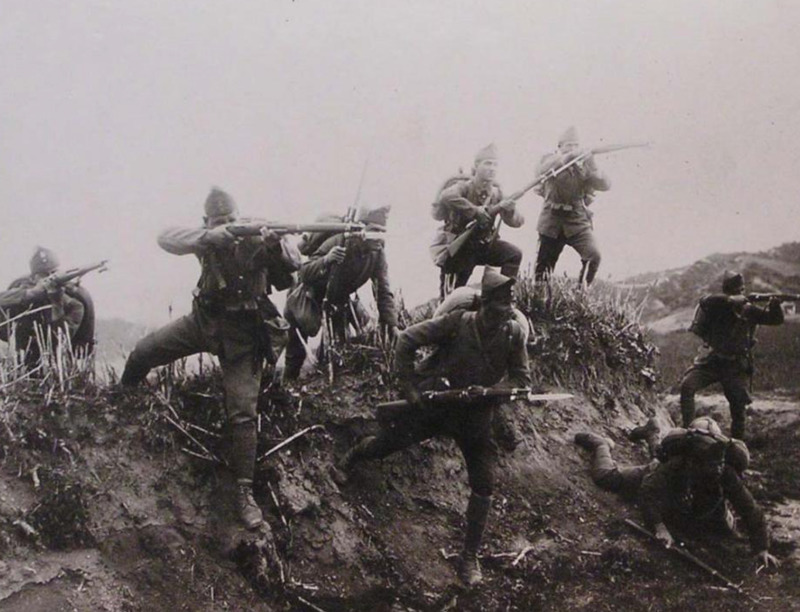The War Before the War: World War I and the Treaty of Sèvres, 1830-1920
This page contains culturally sensitive or racist content and may be considered offensive to some viewers. The events are presented as a representation of cultural history for evaluation and critique. This is not an endorsement from the library but offered as a method to confront challenging histories associated with the objects through scholarship and discussion. Please use your discretion while exploring this page.
The identities of Greece and Turkey began to shift in the 1830s as nationalism spread to Western Asia. Greece emerged as an independent nation-state in 1833, following the Greek War of Independence against the Ottoman Empire. The defeat of the Ottoman Empire demonstrated their decline in power. In response, the empire initiated the Tanzimat Reforms in 1839, which were an attempt to modernize the country's government and military. However, these reforms faced significant backlash within the empire, leading to minimal change.
Despite the creation of a Greek nation-state, Ottoman Greeks remained scattered throughout the Ottoman Empire. Eleftherios Venizelos, who sporadically held the title of Prime Minister of Greece from 1910-1933, rallied support for the Ottoman Greeks. Throughout the 1910s, Venizelos championed the cause to incorporate the Ottoman Greeks into Greece through two methods: the Greek acquisition of Ottoman territory and the voluntary migration of these Greeks to Greece.
Staring intensely into the camera, King Constantine of Greece (left) dons military regalia. He sits with Prime Minister Eleftherios Venizelos (right) near the Vyroneia Railway Station, and papers are spread out on the table between them.
Greece faced internal strife in the years leading up to its invasion of İzmir/Smyrna, and one major conflict was the National Schism. King Constantine led an Atina/Athens-based government on a neutral stance towards World War I, while Venizelos led a Selanik/Thessaloniki-based government bent on joining the war on the side of the Entente Powers. Venizelos allied himself with several prominent European politicians and advocated for Greek intervention in World War I. King Constantine disagreed. This formed the basis for a National Schism. Supporters of Constantine and Venizelos split the nation. Venizelos even set up a rival government in Selanik/Thessaloniki. After the Allies intervened, Greece entered World War I on the side of the Entente in 1917.
The Greeks also clung to the Megali Idea (which is also known as the Great Idea). This was an ambition to restore Greece to its Byzantine Empire-era borders. Not only would this involve the Greek takeover of parts of Anatolia (part of Western Turkey), but also reclaiming İstanbul/Constantinople, which had been taken by the Ottomans in 1453. Venizelos was a proponent of this, and saw it as a way to transform Greece into the dominant state in the region. The plan by necessity involved annexing Ottoman territory, which caused tension between Greece and the Ottoman Empire.
As World War I approached, the Ottoman Empire was in a weakened state. After decades of decline, the empire experienced the Young Turk Revolution in 1908. The Young Turks were revolutionaries who initially pushed for the reestablishment of an Ottoman Parliament and the 1876 constitution. The main party that emerged from the Young Turk Revolution was the Committee of Union and Progress, though it lacked significant power and support outside of Anatolia. Despite these reforms, a sultan remained in the Ottoman Empire until 1922, though only as a figurehead with no real power. However, shortly after this revolution power was centralized in the Three Paşas after their coup d’état: Mehmed Talaat Paşa, minister of the interior, Ismail Enver Paşa, minister of the army, and Ahmed Celat Paşa, the minister of the navy. The Three Paşas pushed for Ottoman entry into World War I, as Celat Paşa authorized preemptive attacks on Russian ports in October 1914 to commit the Ottoman empire to the war on the side of the Central powers.
The Ottoman Empire launched offensives into Egypt and Russia, both campaigns resulted in defeat for the Ottomans. In response, Czar Nicholas II of Russia encouraged the Armenians in the Ottoman Empire to enlist in order to mobilize as many people as possible. The Ottomans, due to a fear of Armenian desertion and the need for a scapegoat, began to uproot Armenian communities. This policy led to inhumane conditions for travel, overexposure, and intentional killing of Armenian populations. The Armenian Genocide set a precedent for separating groups in Anatolia based on religion and ethnicity. Estimates vary, but it is believed that between 600,000 and 1.2 million Armenians died.
During World War I, Mustafa Kemal, who later became the first president of Turkey, made a name for himself as an Ottoman war hero. He is particularly remembered for his performance against the Entente during the campaign in Gallipoli in 1915. Although the Ottomans were able to push the Entente out of Anatolia, they later surrendered on October 30, 1918.
This map depicts the territorial changes of the Ottoman Empire following World War I, and has significant topographical detail. The map has Greece on the left in green, Turkey in the center in orange, and Iran on the right in green. Below Turkey are the British and French mandates of Syria and Mesopotamia (which is modern day Iraq) respectively. Above Turkey is the Black Sea and Crimea, and the Caucasus mountains. Territorial changes are delineated with red lines, such as in Western Anatolia. From top to bottom there is the international zone at İstanbul/Constantinople, Greek claims near İzmir/Smyrna, and the Italian Dodecanese islands.
The Entente divided up Ottoman lands following the war, which effectively heralded the end of the Ottoman Empire. Ottoman lands outside of Anatolia were divided into mandates administered by the French and British. Greece received the Aegean islands, control over İzmir/Smyrna for a period of five years, and Eastern Thrace. The territory surrounding İstanbul/Constantinople became an international zone administered by the League of Nations following the adoption of the Treaty of Sèvres (signed in 1920, negotiations began in 1919). From these terms, it is not hard to see how war might have broken out between Greece and Turkey. Regions such as İzmir/Smyrna had cultural and political ties to both nations. The Greek invasion of İzmir/Smyrna was framed by the Greeks and the Western Europeans as a means for the Greeks to enforce the Treaty of Sèvres.

Language Note

Ashes to Ashes: The Greco-Turkish War and the Burning of İzmir/Smyrna, 1919-1922


